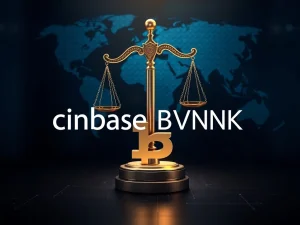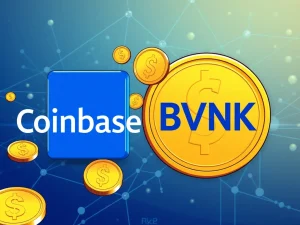Visa Stablecoins: Unleashing a Trillion-Dollar Global Payment Revolution

The financial world is buzzing with a groundbreaking development: Visa, a titan in global payments, is making significant strides in integrating stablecoins into its core infrastructure. This isn’t just a minor update; it’s a strategic pivot set to redefine how money moves across borders. For anyone keen on the future of finance, especially those invested in cryptocurrencies, this move by Visa to embrace Visa stablecoins signifies a major leap towards mainstream digital asset adoption.
Visa’s Bold Move: Redefining Cross-Border Payments
Visa Inc. is not just dabbling in the crypto space; it’s making a profound commitment to leveraging stablecoins for faster, more cost-effective international transactions. This strategic shift aims to streamline global payment systems without disrupting existing retail operations, particularly focusing on emerging markets where traditional banking systems often falter. Executives like Richard Meszaros have highlighted the “significant opportunity for cross-border payments” presented by stablecoins, while Godfrey Sullivan outlined a clear 2025 timeline for solidifying Visa’s stablecoin strategy. The company has already processed over $225 million in cross-border transactions using its Virtual Terminal API (VTAP) platform with stablecoins, demonstrating tangible success.
This initiative directly addresses key inefficiencies in traditional banking:
- Delays: Traditional international transfers can take days. Stablecoins offer near-instant settlement.
- High Fees: Foreign transaction fees often eat into remittance amounts. Stablecoins promise minimal costs.
- Accessibility: Bridging gaps for e-commerce sellers and remittance recipients in underbanked regions.
The Exploding Stablecoin Market and Its Global Reach
Visa’s timing couldn’t be better. The stablecoin market has surged, now exceeding an impressive $250 billion. This growth is largely fueled by the very use cases Visa is targeting: cross-border transactions. Stablecoins, designed to maintain a stable value relative to a fiat currency (like the US dollar), offer the best of both worlds: the efficiency of digital assets with the stability of traditional money.
Key partnerships are central to Visa’s expansion strategy, particularly in Latin America and CEMEA regions. Collaborations with fintech firms aim to enhance disbursements and commerce through stablecoin integration, focusing on remittances and international settlements rather than typical point-of-sale transactions. This reflects a broader industry shift towards tokenized assets, with analysts noting Visa’s incremental approach—rooted in successful 2023 stablecoin settlement pilots with USDC—positions it well to navigate regulatory and technological uncertainties.
Leveraging Blockchain Technology for Future Finance
Visa’s strategy is a testament to the power of blockchain technology. By building on distributed ledger principles, stablecoins offer transparency, immutability, and speed that traditional systems struggle to match. Cuy Sheffield, Visa’s head of crypto, emphasizes the company’s role as a bridge between traditional finance and emerging technologies, prioritizing efficiency and user experience over speculative gains. This measured approach aims to maintain trust in core services while adapting to evolving market demands, distinguishing Visa from purely disruptive DeFi models.
The parallels drawn between Visa’s strategy and Western Union’s preparations for a stablecoin-driven future highlight a crucial industry trend: established players are not ignoring DeFi innovations but are instead seeking complementary solutions. This focus on real-time settlements and reduced costs underscores Visa’s commitment to addressing pain points in global commerce, especially in underbanked markets.
Challenges and the Path to Digital Currency Adoption
Despite the immense potential, challenges persist. Regulatory uncertainties, such as the U.S. GENIUS Act, which could reclassify interest-bearing stablecoins by 2026, pose potential hurdles. Visa’s cautious yet determined strategy—emphasizing stablecoins as a tool for cross-border optimization rather than a wholesale replacement for legacy systems—is designed to mitigate these risks while fostering wider digital currency adoption.
The company’s progress is a clear indicator of the growing intersection between traditional financial infrastructure and blockchain technology. By aligning with stablecoin ecosystems, Visa aims to position itself at the forefront of a transformation in cross-border payments, leveraging its extensive existing network to facilitate broader adoption. This isn’t just about moving money; it’s about building a more inclusive, efficient, and accessible global financial system for everyone.
Conclusion: A New Era for Global Payments
Visa’s strategic integration of stablecoins marks a pivotal moment in the evolution of global finance. With hundreds of millions already processed and a clear vision for 2025, the company is demonstrating that stablecoins are not just a speculative asset but a powerful tool for real-world utility, particularly in the realm of cross-border transactions. This move promises to deliver tangible benefits—faster settlements, lower costs, and greater accessibility—to individuals and businesses worldwide. As the stablecoin market continues its explosive growth, Visa is positioning itself as a key architect of the future of money, seamlessly blending traditional financial prowess with the innovative power of blockchain.
Frequently Asked Questions (FAQs)
Q1: What are Visa stablecoins, and how are they being used?
Visa stablecoins refer to Visa’s strategic integration of stablecoins (cryptocurrencies pegged to stable assets like the USD) into its payment infrastructure. They are primarily being used to facilitate faster, more cost-effective cross-border payments, particularly for e-commerce sellers and remittance recipients, by leveraging their near-instant settlement capabilities and lower transaction fees.
Q2: How much has Visa processed using stablecoins for cross-border payments?
Visa has already processed over $225 million in cross-border transactions via its Virtual Terminal API (VTAP) platform using stablecoins, demonstrating the practical application and potential of tokenized assets in international settlements.
Q3: What is the current size of the stablecoin market, and why is it growing?
The stablecoin market now exceeds $250 billion. Its growth is primarily driven by increasing demand for efficient cross-border payments, remittances, and as a stable medium of exchange within the broader cryptocurrency ecosystem, offering the benefits of digital assets without price volatility.
Q4: How does Visa’s approach to stablecoins differ from decentralized finance (DeFi)?
Visa’s approach is complementary rather than disruptive. While DeFi aims to decentralize financial services, Visa focuses on bridging traditional finance with emerging technologies to enhance existing services like cross-border payments. Visa prioritizes efficiency, user experience, and maintaining trust in its core services, distinguishing its strategy from purely speculative or fully decentralized models.
Q5: What challenges does Visa face with stablecoin integration?
The main challenge is regulatory uncertainty, such as potential reclassification of interest-bearing stablecoins by legislation like the U.S. GENIUS Act. Visa’s measured strategy, emphasizing stablecoins as an optimization tool rather than a replacement for legacy systems, helps mitigate these risks while fostering adoption.







